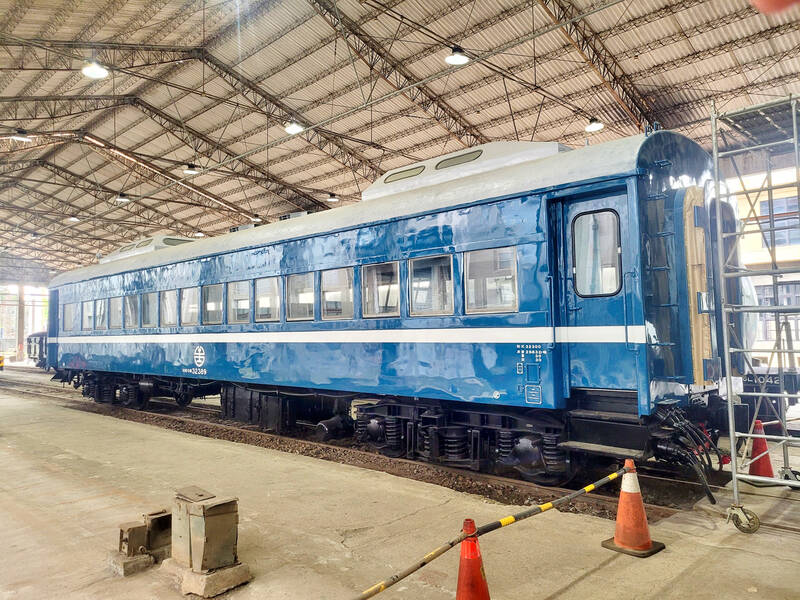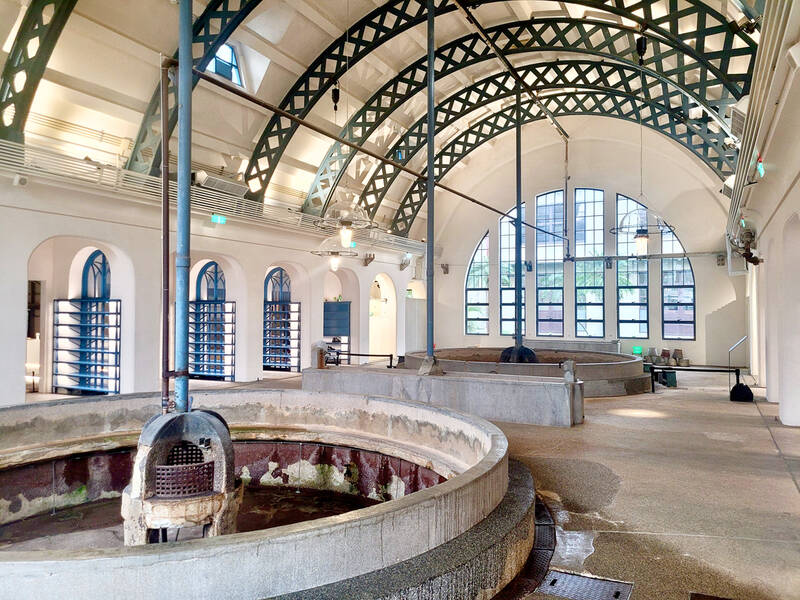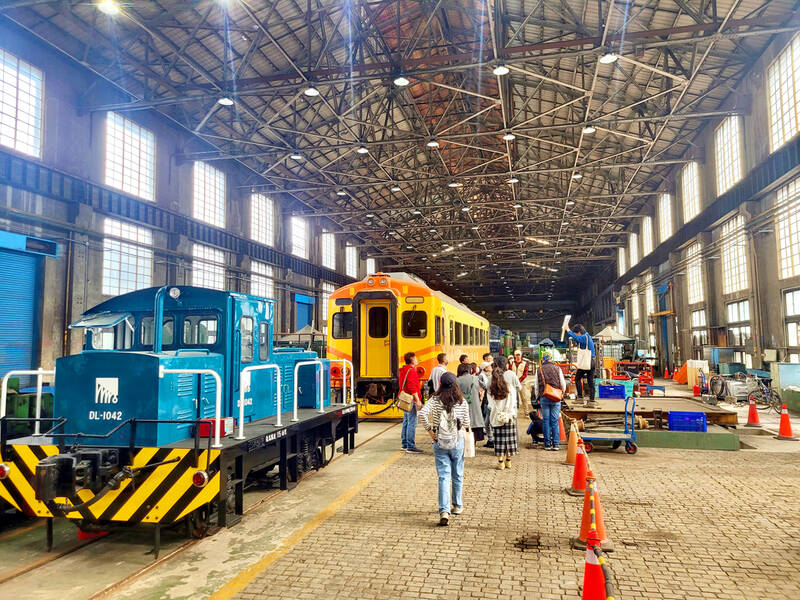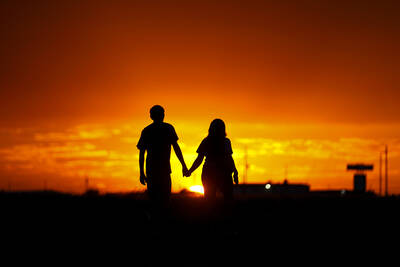For decades, Taiwan Railway trains were built and serviced at the Taipei Railway Workshop, originally built on a flat piece of land far from the city center. As the city grew up around it, however, space became limited, flooding became more commonplace and the noise and air pollution from the workshop started to affect more and more people.
Between 2011 and 2013, the workshop was moved to Taoyuan and the Taipei location was retired. Work on preserving this cultural asset began immediately and we now have a unique opportunity to see the birth of a museum. The Preparatory Office of National Railway Museum is responsible for restoring — or simply preserving — the workshop grounds and opening them up to the public.
The only part regularly open at the moment is the employee bathhouse. With its exhibits and interior restoration, it feels more museum-like than the rest of the grounds, where the piles of disused equipment, tools and materials, as well as the smell of steel and oil, make it seem more like a working factory where the employees just happen to have the day off. This part needs to be cleaned up and made safer before it can be opened to the public on a regular basis, but occasional guided tours do allow a glimpse into this space as it is now.

Photo: Tyler Cottenie
THE BATHHOUSE
Visitors enter the museum through the west wing of the employee bathhouse. This was the earliest part of the Taipei Railway Workshop to be designated as a historic site, for both its architectural and its cultural significance, back in 2000 when the workshop was still in use.
This wing features an exhibit on art deco style buildings throughout Taiwan from the 1930s. The bathhouse itself was built in this decade and in this style, so the exhibit serves to place the building in a broader context. In fact, the bathhouse’s architect also designed two buildings that may be familiar to readers: the Chiayi and Tainan train stations.

Photo: Tyler Cottenie
The showpiece of the building, however, is the central chamber, where the baths themselves were located. The arched ceiling creates an expansive space, abundantly lit by tall windows on either end. Look up at the metal supports that frame this arch and their shape should seem familiar — these are actually old rails that were repurposed for building construction. Two circular pools big enough to hold around 20 people each and a central cold-water sink are the only features on the floor. The pools were heated not by electricity, gas or wood, but rather by excess steam from the workshop’s powerhouse.
Back in the days of steam locomotives, mechanics would be filthy with coal soot by the end of a shift, and so a stop at the baths here was essential before going home. Public baths in this style are not a common part of Taiwanese culture, but they were (and still are) common in Japan. This vestige of Japanese colonial rule remained in use long after the Republic of China (ROC) takeover, and after the switch to the much cleaner diesel-electric locomotives made a post-shift washdown less important. In fact, the baths were still filled, heated and drained daily right up until the workshop closed.
LIMITED ACCESS

Photo: Tyler Cottenie
The remainder of the old railway workshop will continue to open in a piecemeal fashion as museum preparations progress, but for now it is off-limits to visitors — unless you manage to secure a spot on one of the few (approximately 10) guided tours offered each month.
The guides are both knowledgeable and enthusiastic about the workshop’s operation and unique features. Since this is all very recent history, there are plenty of people still around who worked here and can explain anything not obvious to the museum’s new staff. This means that there are very few gaps in the understanding of the workshop and plenty of personal anecdotes to enrich the experience.
The tour takes visitors past the shops for both locomotive and passenger carriage repairs. In the latter, plenty of carriages from different eras sit in various stages of restoration. Take note of the brick flooring as well — without the guide pointing it out, I would have assumed these were concrete bricks. In fact, they are wooden bricks, which help dampen vibrations and are excellent at soaking up any oil that drips on the floor.

Photo: Tyler Cottenie
The tour passes by the employee recreation building, the shop where trains were painted and the steel frames of the overhead cranes that now sit on the ground awaiting proper restoration. The most photogenic part of the tour is perhaps the row of sheds with tracks running both through them and in the narrow spaces between them, where there is just enough room for the trains to scrape by without rubbing up against the buildings.
Registration for the guided tours through the rest of the workshop opens on the 20th day of the month at 10am for all tour dates the following month. For more information, visit: event.culture.tw/TRW (Chinese only). It’s not usually a matter of getting there within the first few seconds, but space is limited and the tours do always fill up. Unfortunately, the tours are currently only available in Chinese.
There are four tour options to choose from: Architectural, Photographic, Master Plan and General. All tours essentially cover the same loop through the workshop grounds allowing you a glimpse of everything, but the emphasis is different.
CHOOSING A TOUR
On the architectural tour, the guide explains special features of each building, including an earthquake and typhoon-resistant flexing roof, the manufacturing of support columns from raw steel sheets and the curious case of one office building whose second floor can only be accessed from an external staircase. This is probably the most informative tour on offer, with the one drawback that there is no time to step inside the restored passenger cars.
The photographic tour does not set aside as much time to explain the features of the workshop or its trains, but gives ample time for visitors to try different angles and lighting to get just the right photo of their favorite parts of the workshop. For those who prefer to capture the industrial atmosphere of the workshop and let their imagination re-create scenes from the past without getting too bogged down by details, this may be the tour for you. If you can’t understand Chinese but still want to see the grounds, this may also be a good option.
The master plan tour takes visitors on a tour with a focus less on the past and more on the potential tourism value of different parts of the workshop. One day, some of the rails and locomotives on the property may be put to use again, carrying visitors into, out of or around the park. Demonstrations of train or rail line maintenance would then also be required, turning the park into more of a living museum. The preparatory office has a grand vision for this newly designated cultural asset, and this tour is the chance to learn more about it.
The general tour covers a little bit of everything and, most importantly, also allows visitors to step into three train carriages, all of which are from a service no longer offered by Taiwan Railways. One car has no air conditioning, only fans in the ceiling and windows that can open, like the Breezy Blue currently running as a tourist gimmick between Taitung and Pingtung counties. The second is the earliest local train to have air conditioning. The final one is the dining car from the 1960s Kuan Kuang trains, beautifully restored to match old photographs as closely as possible.

Not long into Mistress Dispeller, a quietly jaw-dropping new documentary from director Elizabeth Lo, the film’s eponymous character lays out her thesis for ridding marriages of troublesome extra lovers. “When someone becomes a mistress,” she says, “it’s because they feel they don’t deserve complete love. She’s the one who needs our help the most.” Wang Zhenxi, a mistress dispeller based in north-central China’s Henan province, is one of a growing number of self-styled professionals who earn a living by intervening in people’s marriages — to “dispel” them of intruders. “I was looking for a love story set in China,” says Lo,

In the next few months tough decisions will need to be made by the Taiwan People’s Party (TPP) and their pan-blue allies in the Chinese Nationalist Party (KMT). It will reveal just how real their alliance is with actual power at stake. Party founder Ko Wen-je (柯文哲) faced these tough questions, which we explored in part one of this series, “Ko Wen-je, the KMT’s prickly ally,” (Aug. 16, page 12). Ko was open to cooperation, but on his terms. He openly fretted about being “swallowed up” by the KMT, and was keenly aware of the experience of the People’s First Party

It was on his honeymoon in Kuala Lumpur, looking out of his hotel window at the silvery points of the world’s tallest twin skyscrapers, that Frank decided it was time to become taller. He had recently confessed to his new wife how much his height had bothered him since he was a teenager. As a man dedicated to self-improvement, Frank wanted to take action. He picked up the phone, called a clinic in Turkey that specializes in leg lengthening surgery — and made a booking. “I had a lot of second thoughts — at the end of the day, someone’s going

Aug. 25 to Aug. 31 Although Mr. Lin (林) had been married to his Japanese wife for a decade, their union was never legally recognized — and even their daughter was officially deemed illegitimate. During the first half of Japanese rule in Taiwan, only marriages between Japanese men and Taiwanese women were valid, unless the Taiwanese husband formally joined a Japanese household. In 1920, Lin took his frustrations directly to the Ministry of Home Affairs: “Since Japan took possession of Taiwan, we have obeyed the government’s directives and committed ourselves to breaking old Qing-era customs. Yet ... our marriages remain unrecognized,